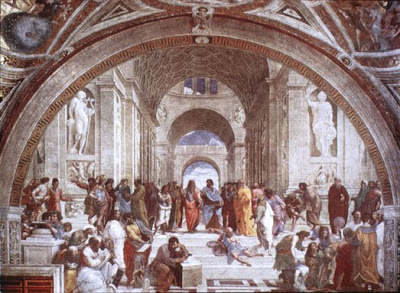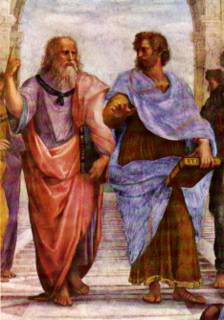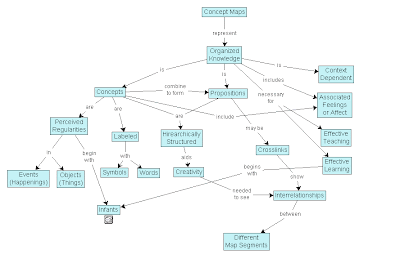A picture, a photograph, or a painting is not the real world that it depicts. It's flat, not full with three dimensional depth like the real thing. Look at it from the side-almost edge on. It doesn't look anything like the real scene view from a angle. In short it's two dimensional while the world is three dimensional. The artist, using perceptual sleight of hand, has conned you into producing a three dimensional image in your brain, but in fact the information just isn't there to form a three dimensional model of the scene. There is no way to tell if that figure is a distant giant or a close midget There is no way to tell if the figure is made of plaster or if it's filled with blood or guts. The brain is providing information that is not really present in the painted strokes on the canvas or the darken grains of silver on the photographic surface. The Cosmic Landscape by Leonard Susskind, page 337 and 338
So while we design our methods of picturing how the universe looks, it is by design of the experimental procedures that we have pushed perspective toward the "depth of imaging" that we design our views of what we propose is happening . So this then is a method based on the Gedankin that allows "an alternate view of the reality" of what is happening inside the blackhole that was "thought of" before we master putting the perspective of what actually happens outside.
Gedanken Experiments Involving Black Holes
ABSTRACT
Analysis of several gedanken experiments indicates that black hole complementarity cannot be ruled out on the basis of known physical principles. Experiments designed by outside observers to disprove the existence of a quantum-mechanical stretched horizon require knowledge of Planck-scale effects for their analysis. Observers who fall through the event horizon after sampling the Hawking radiation cannot discover duplicate information inside the black hole before hitting the singularity. Experiments by outside observers to detect baryon number violation will yield significant effects well outside the stretched horizon.
At 11:20 AM, September 13, 2009,Bee said-The Schwarzschild radius depends on the mass, it thus doesn't define a fixed length. If one ties the Schwarzchild radius to the Compton wavelength via the uncertainty principle, one obtains a length and a mass, which is exactly the Planck length and Planck mass
Seth Lloyd is a professor of mechanical engineering at Massachusetts Institute of Technology. He refers to himself as a "quantum mechanic".
While one recognizes the relationship Susskind had pointed out by doing thought experiments in relation to what processes allow us to search "inside the blackhole" it is information that is "not lost" that allows us to understand what is actually happening with time that moves within the blackhole's internal direction . This then is an "outside perspective" of what is held in contention to Planck's length that we might ask what the heck actually exist inside that we are all speculating about?
Quantum Entanglement Benefits Exist after Links Are Broken
By Charles Q. Choi“Spooky action at a distance” is how Albert Einstein famously derided the concept of quantum entanglement—where objects can become linked and instantaneously influence one another regardless of distance. Now researchers suggest that this spooky action in a way might work even beyond the grave, with its effects felt after the link between objects is broken.
In experiments with quantum entanglement, which is an essential basis for quantum computing and cryptography, physicists rely on pairs of photons. Measuring one of an entangled pair immediately affects its counterpart, no matter how far apart they are theoretically. The current record distance is 144 kilometers, from La Palma to Tenerife in the Canary Islands.
In practice, entanglement is an extremely delicate condition. Background disturbances readily destroy the state—a bane for quantum computing in particular, because calculations are done only as long as the entanglement lasts. But for the first time, quantum physicist Seth Lloyd of the Massachusetts Institute of Technology suggests that memories of entanglement can survive its destruction. He compares the effect to Emily Brontë’s novel Wuthering Heights: “the spectral Catherine communicates with her quantum Heathcliff as a flash of light from beyond the grave.”
The insight came when Lloyd investigated what happened if entangled photons were used for illumination. One might suppose they could help take better pictures. For instance, flash photography shines light out and creates images from photons that are reflected back from the object to be imaged, but stray photons from other objects could get mistaken for the returning signals, fuzzing up snapshots. If the flash emitted entangled photons instead, it would presumably be easier to filter out noise signals by matching up returning photons to linked counterparts kept as references.
Still, given how fragile entanglement is, Lloyd did not expect quantum illumination to ever work. But “I was desperate,” he recalls, keen on winning funding from a Defense Advanced Research Projects Agency’s sensor program for imaging in noisy environments. Surprisingly, when Lloyd calculated how well quantum illumination might perform, it apparently not only worked, but “to gain the full enhancement of quantum illumination, all entanglement must be destroyed,” he explains.
Lloyd admits this finding is baffling—and not just to him. Prem Kumar, a quantum physicist at Northwestern University, was skeptical of any benefits from quantum illumination until he saw Lloyd’s math. “Everyone’s trying to get their heads around this. It’s posing more questions than answers,” Kumar states. “If entanglement does not survive, but you can seem to accrue benefits from it, it may now be up to theorists to see if entanglement is playing a role in these advantages or if there is some other factor involved.”
As a possible explanation, Lloyd suggests that although entanglement between the photons might technically be completely lost, some hint of it may remain intact after a measurement. “You can think of photons as a mixture of states. While most of these states are no longer entangled, one or a few remain entangled, and it is this little bit in the mixture that is responsible for this effect,” he remarks.
If quantum illumination works, Lloyd suggests it could boost the sensitivity of radar and x-ray systems as well as optical telecommunications and microscopy by a millionfold or more. It could also lead to stealthier military scanners because they could work even when using weaker signals, making them easier to conceal from adversaries. Lloyd and his colleagues detailed a proposal for practical implementation of quantum illumination in a paper submitted in 2008 to Physical Review Letters building off theoretical work presented in the September 12 Science. See: more here











 PLato saids,"Look to the perfection of the heavens for truth," while Aristotle saids "look around you at what is, if you would know the truth" To Remember: Eskesthai
PLato saids,"Look to the perfection of the heavens for truth," while Aristotle saids "look around you at what is, if you would know the truth" To Remember: Eskesthai




